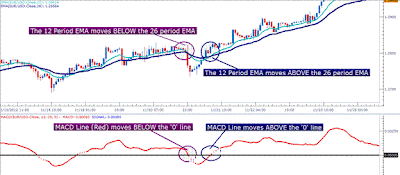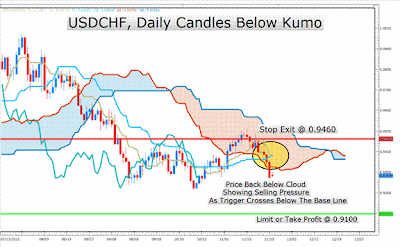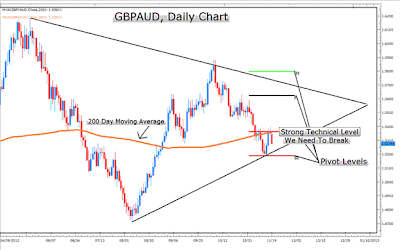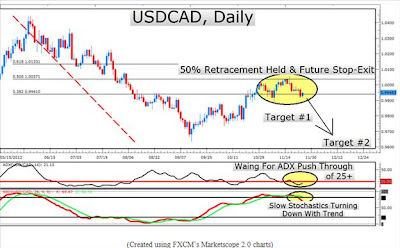The MACD indicator is generally one of the first used by beginner trader. But Moving Average Convergence Divergence doesn't work all the time after knowing that not every trading signal would have worked out well. In this blog, we'll going to learn at bow Moving average convergence divergence is built, MACD divergence trading, fx5 MACD indicator, what is MACD histogram, how to trading MACD divergence and etc.
We will then move on to find at systems that Forex traders can find to trade with MACD histogram in our next post, simple trading system using MACD momentum indicator.
What build up Moving Average Convergence Divergence ?
Moving average convergence divergence is very simple trading indicator, this indicator calculates 2 EMA indicator. The default settings for MACD indicator are calculating Exponential Moving Average of 12, and 26 periods and the signal line of 9 periods moving average indicator.
In bearish markets, the fast MA will trade bearish faster than the slow MA indicator. As the fast MA indicator diverges from the slow MA indicator. And in bullish markets, the 12 Exponential moving average will trade bullish faster than the 26 period Exponential moving average. Moving Average Convergence Divergence trade higher to express this moving difference between 12 MA and 26 MA indicator. The following chart will show this situation, with the 12 period exponential moving average and 26 period exponential moving average traded on the graph along with Moving Average Convergece Divergence using 12 and 26 exponential moving average.
MACD forex indicator helps traders to determine the market trend change, as the blue boxes in the image above began before the bearish trend was finished.
The 0 line is a main section of the MACD, as it tells us when there is no difference between the Exponential moving averages. Moving average convergence divergence will cross the 0 line as the fast MA indicator crosses the slow MA indicator.
Moving average convergence divergence can be helpful for determining trend reversal at the beginning. When we wait zero line crossover, we're trading a MA indicator crossover. The signal is only a MA indicator made on the MACD indicator line, and this value is usually set at 9 periods moving average.
Usually forex traders will find for trading chances if MACD indicator intercepts the signal line. And if MACD indicator line intercept above and over the signal line, it is called long signal and if MACD indicator intercept under the signal line, it called at as a short signal.
The MACD histogram
The MACD histogram is the relationship between the Moving Average Convergence Divergence and signal lines, Forex traders can use the MACD histogram , which is only a bar around the zero line.
in the following chart - when MACD indicator intercepts the signal line, the histogram will cross the zero line. If MACD crosses above and over the signal line, the histogram will move up from the zero line and if MACD indicator intercepts below the signal line the MACD histogram will move below the zero line.
The MACD default settings are 12, 26 and 9. These settings can make too many trading signals. Forex traders searching to take trading signals from MACD indicator.
Thursday, December 6, 2012
Wednesday, December 5, 2012
Range Trading with RSI Indicator
In this article we will learn range trading with RSI Relative Strength Index indicator. Forex traders usually concentrate on market trend , but sometime they may get times where Forex pair move in sideways. These situation are noticed as ranging markets and are generally marked on a Forex chart by determining horizontal levels of resistance and support.
In this article we can find an example chart of a range market. Support level is made by connecting a series of market lows. Resistance level is made by connecting a series of market highs. With these range areas we can then proceed with range trading plan to long or short at these specific price levels. To better entries we will be using RSI Forex indicator.
Relative Strength Index is a great indicator, this indicator can be traded in both range and trending market. Momentum is key and we can see on the following Forex chart that the previous RSI signal gave us to short resistance as Relative strength index traded from overbought areas. As market price trading bearish Forex traders can find for a right signal to buy the currency pair at support if Relative strength index indicator becomes oversold.
Range traders like trading in a Forex market without a clear market prediction. Forex traders can long and short between resistance and support levels until market price breaks the support or resistance level. Since there is a chance of a breakout, range trader set a stop when trading. They set stop orders outside of support when long or resistance when short.
Using the Relative strength index with the graph, my suggestion is to short the currency on a reverse from overbought areas. New positions cam target range support with stop loss level plotted above of resistance level. Profit target could be plotted close support.
In this article we can find an example chart of a range market. Support level is made by connecting a series of market lows. Resistance level is made by connecting a series of market highs. With these range areas we can then proceed with range trading plan to long or short at these specific price levels. To better entries we will be using RSI Forex indicator.
Relative Strength Index is a great indicator, this indicator can be traded in both range and trending market. Momentum is key and we can see on the following Forex chart that the previous RSI signal gave us to short resistance as Relative strength index traded from overbought areas. As market price trading bearish Forex traders can find for a right signal to buy the currency pair at support if Relative strength index indicator becomes oversold.
Range traders like trading in a Forex market without a clear market prediction. Forex traders can long and short between resistance and support levels until market price breaks the support or resistance level. Since there is a chance of a breakout, range trader set a stop when trading. They set stop orders outside of support when long or resistance when short.
Using the Relative strength index with the graph, my suggestion is to short the currency on a reverse from overbought areas. New positions cam target range support with stop loss level plotted above of resistance level. Profit target could be plotted close support.
Tuesday, December 4, 2012
How to trade Ichimoku Indicator ?
Ichimoku Kinko Hyo is a great Forex trading strategy that has been traded by Forex participants for many years ago. Ichimoku kinko hyo trend indicator consists two MA trend indicator and a cloud to show a better analyze of potential market price action. Ichimoku Kinko Hyo Forex indicator is built using 50% point of the lows and highs to candlestick's closing price.
The ichimoku clouds let us to identify the market price action. How to trade Ichimoku Kinko Hyo trend indicator
Buy entry
- If the kumo cloud is under the market price.
- Kikun sen is bellow tenkan sen
- Market price action is below chikou line
- Entry trade isn't more than 150 pips away from the tenkan sen.
Ichimoku Trading example
The Ichimoku trend indicator presents a strong signal to short position as market price trade reverse under the cloud. Market price has been bellow the cloud. We also notice that the tenkan sen is pending a cross under the kijun sen which gives a bearish or sell opportunity. The rejection of the bullish move in the middle of the cloud gives a opportunity to open short position in the way of the market trend.
The Ichimoku Kinko Hyo is great trend indicator, another important component of ichimoku kinko hyo indicator is the chikou span. The chikou span is the teal line which is last market price plotted back 26 periods. The purpose of Chikou is to bring you a picture of whether or not market price is lower or higher than it was 26 days on month ago.
When the chikou is traded above the cloud, it is uptrend for the forex pair. The trigger line is also above the chikou even the market price touched and reversed the chikou line before.
The ichimoku clouds let us to identify the market price action. How to trade Ichimoku Kinko Hyo trend indicator
Buy entry
- If the kumo cloud is under the market price.
- Kikun sen is bellow tenkan sen
- Market price action is below chikou line
- Entry trade isn't more than 150 pips away from the tenkan sen.
Ichimoku Trading example
The Ichimoku trend indicator presents a strong signal to short position as market price trade reverse under the cloud. Market price has been bellow the cloud. We also notice that the tenkan sen is pending a cross under the kijun sen which gives a bearish or sell opportunity. The rejection of the bullish move in the middle of the cloud gives a opportunity to open short position in the way of the market trend.
The Ichimoku Kinko Hyo is great trend indicator, another important component of ichimoku kinko hyo indicator is the chikou span. The chikou span is the teal line which is last market price plotted back 26 periods. The purpose of Chikou is to bring you a picture of whether or not market price is lower or higher than it was 26 days on month ago.
When the chikou is traded above the cloud, it is uptrend for the forex pair. The trigger line is also above the chikou even the market price touched and reversed the chikou line before.
Monday, December 3, 2012
Triangle Pattern Trading Example
If we look at the following chart, you will see a triangle chart pattern forming. An ascending triangle chart pattern with the rising bottom. Triangle chart pattern let us to determine congested market price action so that we can take a bigger chance trading.
A great thing about triangle chart pattern trading is that our risk is determined based on main price action. In the following chart we can see the price levels that we want to concern on should the triangle continue to play course.
We can see the 200 MA and pivot point to assist us determine the risk on the transaction. The 200 MA is plotted as a support or resistance level for most traders. This mean that the foreign exchange market wouldn't push you to open long position if market price is under the 200 MA.
On the market graph above we can notice the 200 MA separating market price down the middle. We can find to transaction back to the top of the triangle chart pattern if market price as crossed and closed above the 200 MA. You should not take a risk until the 200 MA Moving average indicator is below the market price.
Market price is under the 200 MA and stay at 1.5361. We can use an entry order to open trading position if market price touches this price level. We also use the pivot point levels that market price has respected in light of the triangle chart pattern. If you are not familiar with pivot point trading system, they are made from the first to the last of the current month based on last month's market price action. There are so many Foreign exchange traders use pivot point levels with chart pattern to assist them determine entry levels.
The second price level of support (S2) align with the rising triangle when you see a bullish engulfing pattern. We can use this as a stop loss level and plot our risk under the 2nd support because market price refused moving under this support level before.
We now have a determined entry with the 200 MA trend indicator. We have a risk level plot under the second support level which is built the ascending triangle chart patter. And then we will find at reliable targets.
The MA trend indicator is trade 175 points from the second support price level. And we have to look for a target at least 200 points. The pivot points level is at 1.5630 or 266 points from the target. We can also set our target at the highest of the triangle chart pattern.
A great thing about triangle chart pattern trading is that our risk is determined based on main price action. In the following chart we can see the price levels that we want to concern on should the triangle continue to play course.
We can see the 200 MA and pivot point to assist us determine the risk on the transaction. The 200 MA is plotted as a support or resistance level for most traders. This mean that the foreign exchange market wouldn't push you to open long position if market price is under the 200 MA.
On the market graph above we can notice the 200 MA separating market price down the middle. We can find to transaction back to the top of the triangle chart pattern if market price as crossed and closed above the 200 MA. You should not take a risk until the 200 MA Moving average indicator is below the market price.
Market price is under the 200 MA and stay at 1.5361. We can use an entry order to open trading position if market price touches this price level. We also use the pivot point levels that market price has respected in light of the triangle chart pattern. If you are not familiar with pivot point trading system, they are made from the first to the last of the current month based on last month's market price action. There are so many Foreign exchange traders use pivot point levels with chart pattern to assist them determine entry levels.
The second price level of support (S2) align with the rising triangle when you see a bullish engulfing pattern. We can use this as a stop loss level and plot our risk under the 2nd support because market price refused moving under this support level before.
We now have a determined entry with the 200 MA trend indicator. We have a risk level plot under the second support level which is built the ascending triangle chart patter. And then we will find at reliable targets.
The MA trend indicator is trade 175 points from the second support price level. And we have to look for a target at least 200 points. The pivot points level is at 1.5630 or 266 points from the target. We can also set our target at the highest of the triangle chart pattern.
Sunday, December 2, 2012
ADX Best Trend Indicator
Participating into a quiet market trend is very difficult things. Many Forex traders have trading systems for trend trading entry but when a market trend has trade it is course and is fading then it is of no use to you. Using ADX trend indicator with a trend trading system can assist you trade breakouts and reverses with bigger chance. The Average Directional movement index is traded to calculate market trend strength. The use is very easy. The Average Directional Movement index filter can have beneficial impacts on your trading results. The ADX trend indicator calculates only strength but not trend bias. This lets the Forex trader to pick the strongest trends to trade.
The currency chart above shows a bullish trend with multiple trades as the Average Directional Movement index trend indicator on the bottom presents a main of reading above the strong trend. The red line as a reference level of when the tool presents a strong market trend. To determine the trend strength, we suggest searching for trend entry only if the Average Directional Movement Index is above level 25.
Average Directional Movement Index trading rule
When moving trends, the Average Directional Movement Index Moves above when market is in strong market. When the market trend is fade , Average directional movement index moves bearish.
Average directional movement index isn't a directional technical indicator, just a strength indicator.
If you are searching for trend bias, I suggest using indicator to search reversals in the trend direction of the market trend or breakouts trading with the Average directional movement index. this will give bigger chance set ups with a strengthening trend.
Trading in strong market trends
- We can set up the risk but not the market.
- Just trading the bigger chance set ups that match your trading system
- Trading with Average Directional movement index lets you to identify a last potential trade to see if the entry is worth the risk.
- ADX id the indicator we will use to identify whether a bearish move is worth trading on a short trade. Average directional movement index also be traded in the same situation to grasp if an move is worth trading on a long trade. Either system the Average directional movement index will break through 25 level to show us that a strong trend is in market.
Chart example above shows us the strong bearish move
Here are the indicators at set on the graph above :
- Average directional movement index for determining market strength
- Fibonacci retracement for identify support in a bearish trend
- Stochastic indicator for determining overbought or oversold reversal.
We will analyze on the ADX indicator to trade through 25 level. If the ADX indicator breakout through 25, we have the indicator's signal to trade in the direction of the market trend. The instrument above trend on the D1 graph is bearish. Because the ADX indicator is not move yet. Fibonacci is a favorite tool to determine right levels to determine reversal move. Support level in a bearish trend is potentially at one of these price levels and if the instrument bounces off these points we can search to enter off that resistance level in a bearish trend.
A popular level is the 50% level. If the instrument can not keep 50% of its trade, then it may break down and reverse the overall trend. We can see above that the Forex market kept the 50% and is searching to trade bearish. When the average directional movement index or ADX indicator trades through we have another confirmation.
The stochastic trading indicator calculates a instrument closing price to its range over a given period. The 20 level gives an oversold area and the 80 level presents an overbought situation. We can set up the Stochastic's time period to eliminate the false signals to market movements. During a bearish trend to close near their lows. Slow stochastic indicator signal show in a bearish trend if the stochastick indicator reverses bearish below 80 level after a temporary bullish swing in the currency market. This gives bigger chance entries.
The ADX indicator calculates trend strength, and lets you to combine the other technical indicators to make sure you are only trading the strong trends. This trading system can hold you out of risky markets if your analyze is allowing your target run on a trend.
The currency chart above shows a bullish trend with multiple trades as the Average Directional Movement index trend indicator on the bottom presents a main of reading above the strong trend. The red line as a reference level of when the tool presents a strong market trend. To determine the trend strength, we suggest searching for trend entry only if the Average Directional Movement Index is above level 25.
Average Directional Movement Index trading rule
When moving trends, the Average Directional Movement Index Moves above when market is in strong market. When the market trend is fade , Average directional movement index moves bearish.
Average directional movement index isn't a directional technical indicator, just a strength indicator.
If you are searching for trend bias, I suggest using indicator to search reversals in the trend direction of the market trend or breakouts trading with the Average directional movement index. this will give bigger chance set ups with a strengthening trend.
Trading in strong market trends
- We can set up the risk but not the market.
- Just trading the bigger chance set ups that match your trading system
- Trading with Average Directional movement index lets you to identify a last potential trade to see if the entry is worth the risk.
- ADX id the indicator we will use to identify whether a bearish move is worth trading on a short trade. Average directional movement index also be traded in the same situation to grasp if an move is worth trading on a long trade. Either system the Average directional movement index will break through 25 level to show us that a strong trend is in market.
Chart example above shows us the strong bearish move
Here are the indicators at set on the graph above :
- Average directional movement index for determining market strength
- Fibonacci retracement for identify support in a bearish trend
- Stochastic indicator for determining overbought or oversold reversal.
We will analyze on the ADX indicator to trade through 25 level. If the ADX indicator breakout through 25, we have the indicator's signal to trade in the direction of the market trend. The instrument above trend on the D1 graph is bearish. Because the ADX indicator is not move yet. Fibonacci is a favorite tool to determine right levels to determine reversal move. Support level in a bearish trend is potentially at one of these price levels and if the instrument bounces off these points we can search to enter off that resistance level in a bearish trend.
A popular level is the 50% level. If the instrument can not keep 50% of its trade, then it may break down and reverse the overall trend. We can see above that the Forex market kept the 50% and is searching to trade bearish. When the average directional movement index or ADX indicator trades through we have another confirmation.
The stochastic trading indicator calculates a instrument closing price to its range over a given period. The 20 level gives an oversold area and the 80 level presents an overbought situation. We can set up the Stochastic's time period to eliminate the false signals to market movements. During a bearish trend to close near their lows. Slow stochastic indicator signal show in a bearish trend if the stochastick indicator reverses bearish below 80 level after a temporary bullish swing in the currency market. This gives bigger chance entries.
The ADX indicator calculates trend strength, and lets you to combine the other technical indicators to make sure you are only trading the strong trends. This trading system can hold you out of risky markets if your analyze is allowing your target run on a trend.
Subscribe to:
Comments (Atom)










